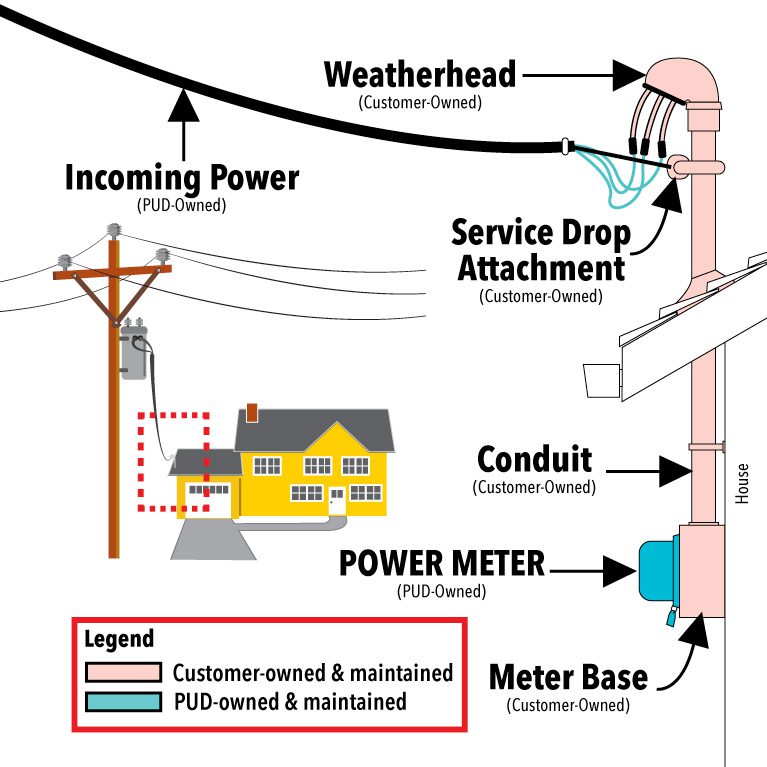What’s that? Weatherhead & Service Drop
Let’s take a closer look at where the electrical grid meets the home.
Electrical service to the home can be overhead (known as a “service drop”) or underground (known as a “service lateral”). The connection, which may not always be visible, is a mix of customer-owned components and PUD-owned pieces.
For this ‘What’s that?’ we will focus on the aboveground components, starting with the  snorkel-looking apparatus called the “weatherhead”. The weatherhead provides a safe, dry location for power to enter the home (or at least the exterior of the home). The weatherhead is a curved metal piece connected to a “service mast” that extends down to the electrical meter. A service drop attachment is placed from the mast or anchored to the home, and connects to the incoming PUD line to help reduce sag. This provides space for a loop so the incoming PUD line can meet the lines owned by the customer. The goal of this loop is to reduce tension on the connection so line movement caused by wind doesn’t cause a break. Customer-owned lines are fed by an electrician through pre-sized holes in the weatherhead, down the service mast and into the meter base.
snorkel-looking apparatus called the “weatherhead”. The weatherhead provides a safe, dry location for power to enter the home (or at least the exterior of the home). The weatherhead is a curved metal piece connected to a “service mast” that extends down to the electrical meter. A service drop attachment is placed from the mast or anchored to the home, and connects to the incoming PUD line to help reduce sag. This provides space for a loop so the incoming PUD line can meet the lines owned by the customer. The goal of this loop is to reduce tension on the connection so line movement caused by wind doesn’t cause a break. Customer-owned lines are fed by an electrician through pre-sized holes in the weatherhead, down the service mast and into the meter base.
A weatherhead, depending on the height of the home, can be mounted above the roofline (as shown in the illustration), or mounted to the home itself. The goal is to ensure the “belly” of the incoming utility line stays a safe distance above the ground.
Below the roofline, down the service mast, the meter base is mounted to the home. The meter base is a metal box often located near the homes electrical panel. Meter bases are universal (with a few exceptions) to allow a utility to use any meter needed. The meter itself and the metal seal ring are owned and maintained by the PUD.
It’s important to remember that any components involving incoming power and electric meters should be treated with caution. Incoming power is often 240V or higher and can be deadly.
Here are some tips for staying safe around service drops:
- Never touch a service drop, even if it is down on the ground.
- If you are planting trees or shrubs, be careful not to plant them too close to service drops.
- Maintain trees and brush to avoid contacting incoming service lines.
- If your service drop is damaged, stay away and call an electrician. If power is out to the home, contact the PUD immedaitely.
- If you are working on your home, be careful with ladders to avoid damaging the service drop.
If a weatherhead or service mast is ever damaged, contact a qualified electrician immediately.